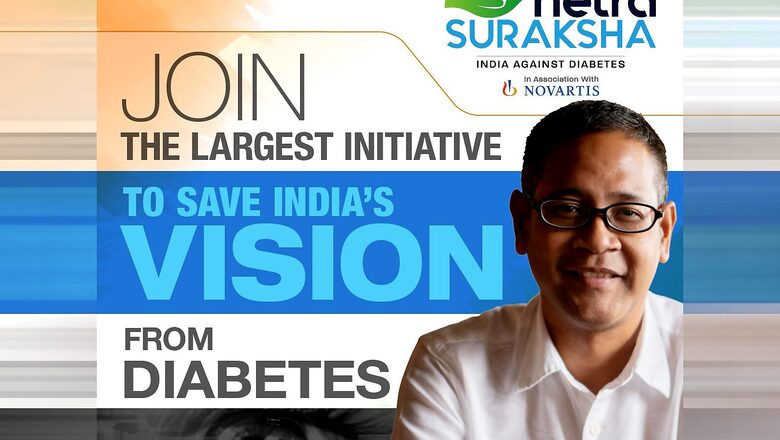
views
Take the NetraSuraksha Online Self Check-Up here.
It?s one of the many myths that diabetes only happens to people who are overweight, fond of sweets, and older. The facts, however, tell a different story. According to the International Diabetes Federation Atlas 20211:
- Around 537 million adults aged 20-79 years have diabetes, a number is estimated to reach 643 million by 2030, and 784 million by 2045.
- An estimated 1.2 million children and adolescents (aged under 20 years) have type 1 diabetes.
- An estimated 21 million children were born affected by hyperglycemia in pregnancy in 2021.
The numbers in India aren?t easy to look at. According to the atlas, there were 74 million patients with diabetes in India in 2021, and the number is expected to grow to 93 million in 2030 and 124 million in 20451. Additionally, almost 39.3 million people in India are estimated to be patients with diabetes who are undiagnosed1.
It?s a sobering thought, particularly since diabetes is, largely, an urban disease. Indians are becoming increasingly urban and increasingly sedentary ? often a function of our office jobs. Type II diabetes is considered a lifestyle disease, and is therefore entirely preventable. All one needs is information, and the right medical interventions at the right time. In fact, most doctors today believe diabetes to be reversible if caught early and managed well.
So let?s begin with a little information. Diabetes is a condition where the body can?t produce enough insulin, or make use of the insulin it is producing. Insulin is a hormone produced in the pancreas and helps the body use up the glucose in our blood. There are 3 types of diabetes4: Gestational Diabetes Mellitus (mothers sometimes develop this during pregnancy), Type I diabetes (usually manifests in childhood, and has genetic attributes) and Type II (the preventable lifestyle disease, which accounts for roughly 90% of diabetes cases).
The symptoms that you should know about are: frequent urination, excessive thirst, blurred vision, lack of energy, fatigue, constant hunger and sometimes sudden weight loss and bedwetting4. If you have any combination of these symptoms, it?s time to get tested. Diabetes isn?t just going to make you tired and cranky; it does real harm to the body.
Diabetes and elevated blood glucose levels are associated with a doubling of cardiovascular disease risk4. Diabetes, when combined with hypertension, causes 80% of end stage kidney disease globally4. 40-60 million people around the world face diabetic foot and lower limb complications ? painful ulcers and a chronic condition called peripheral vascular disease that severely limits their mobility4.
However, the most frightening, and yet the most preventable complication of diabetes is Diabetic Retinopathy which, according to the National Eye Institute of the US National Institutes of Health, affects more than half of people with diabetes during the course of their disease2. The tricky part is that there are no symptoms in the early stages of the disease. Some people notice changes in their vision, like trouble reading or seeing faraway objects. But it comes and goes. At later stages, blood vessels in the retina begin to bleed, creating floating spots, and in some extreme cases, total loss of vision2.
This is why screening is important. In fact, within just 8 years of implementing a policy of regular screening for Diabetic Retinopathy, it is no longer the leading cause for blindness among the working age population in the UK4. In Wales, it resulted in a 40-50% reduction in new certifications for visual impairment4f.
So, we know screening works. But it only works if you participate. According to the National Diabetes and Diabetic Retinopathy Survey, India (2019), almost 90% of known patients with diabetes had never gone for an eye evaluation for Diabetic Retinopathy3.
This is what inspired Network18 to launch the ?Netra Suraksha? ? India Against Diabetes initiative, in association with Novartis India, which focuses particularly on Diabetic Retinopathy. Launched on 27th November, 2021, the initiative kicked off with a series of roundtable discussions on Diabetic Retinopathy which you can watch on YouTube, News18.com and on Facebook.
There are two more roundtable sessions scheduled in the coming weeks. The initiative enlists the help of the medical community, think tanks and policymakers in the battle. You can also look forward to several explainer videos and articles on News18.com.
The aim of the initiative is simple: to give you the information you need, to take yourself and your loved ones in for a simple, painless eye test that can make all the difference to your quality of life in the years to come.
Start with the Diabetic Retinopathy Self Check Up here, and maybe also get a blood test if you haven?t had one in a while. The numbers around diabetes and Diabetic Retinopathy are hard to look at, particularly for us office goers in Indian cities, but at least we have the privilege of using our eyes to see them. Let?s keep it that way.
Follow #NetraSuraksha for more updates about the Netra Suraksha ? India Against Diabetes initiative, and involve yourself in India?s fight against Diabetic Retinopathy.
Sources:
- IDF Atlas, International Diabetes Federation, 10th edition, 2021
- https://www.nei.nih.gov/learn-about-eye-health/eye-conditions-and-diseases/diabetic-retinopathy
- National Blindness and Visual Impairment Survey 2015-2019, Ministry of Health and Family Welfare, Government of India. Dr Rajendra Prasad Centre for Ophthalmic Sciences, AIIMS, New Delhi
- IDF Atlas, International Diabetes Federation, 9th edition, 2019
Read all the Latest Lifestyle News here

















Comments
0 comment